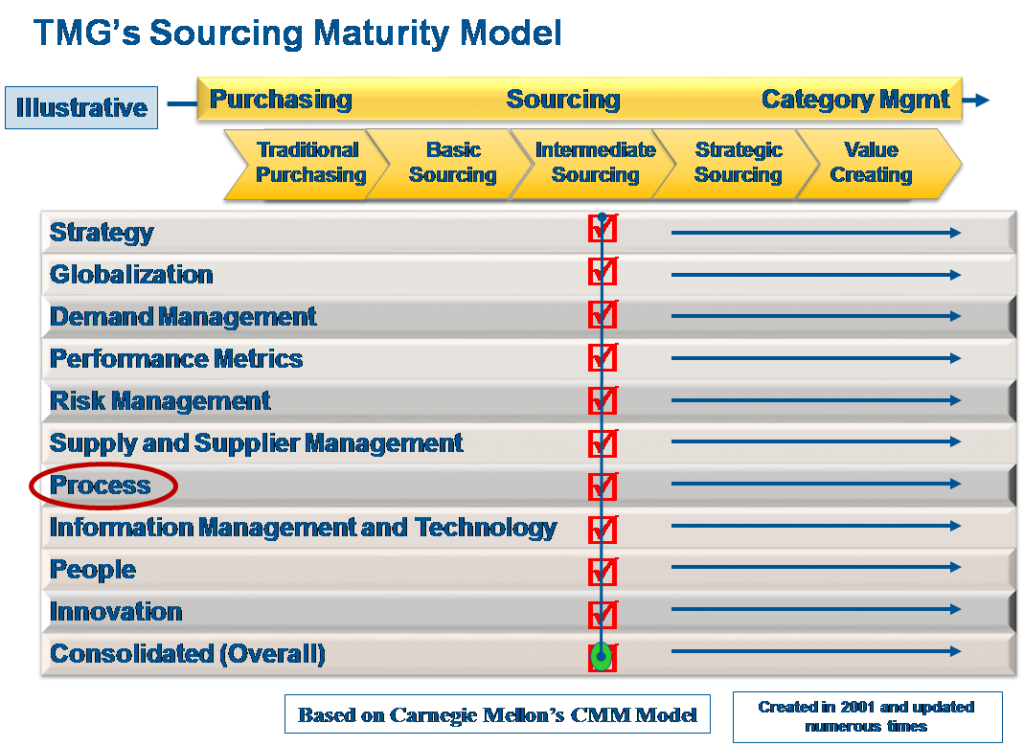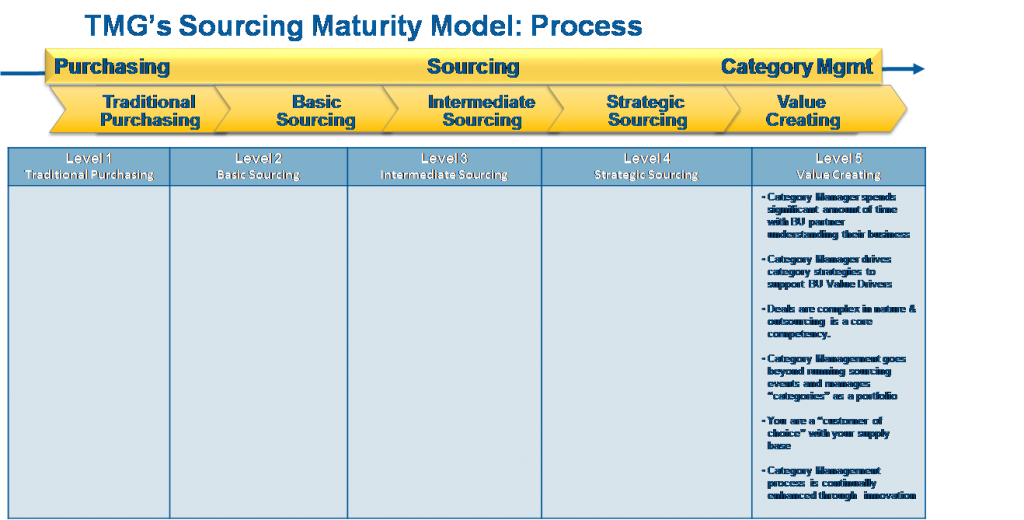Let’s talk process!!! I assume this is the area where we may have the MOST disagreement. I often hear from clients that Strategic Sourcing and Category Management are interchangeable terms for the same process and I must admit that many, many organizations use them that way. But, we believe that there is a SIGNIFICANT difference and that you must have mastered Strategic Sourcing to move to the next level of maturity which is Value Creating (Category Management).

Let’s look at the details within the Process domain:

Category Manager spends significant amount of time with BU partner understanding their business – One of the biggest differences between Strategic Sourcing and Category Management is the amount of time spent with the Business Unit. This is the first question I ask when told that an organization is already doing Category Management. At this level, you ARE a strategic business partner who is engaged to help drive the strategic objectives of that business. The Category Management process includes a heavy dose of planning and interaction with the Business Unit throughout the buying process.
Category Manager drives category strategies to support BU Value Drivers – Category Management focuses on and is measured by satisfying the business or Value Drivers of the Business NOT just cost savings which is how most Strategic Sourcing processes are measured.
Deals are complex in nature and outsourcing is a core competency – The Category Management process has outsourcing and insourcing as key options when developing category strategies. At this level, you are leading major outsourcing processes across your organization.
Category Management goes beyond running Sourcing events and manages “categories” as a portfolio – If your organization is still putting plans together from a spend analysis to decide which “categories” need to be sourced this year, then you are NOT doing Category Management. The big process difference here is that a Category Manager is designated to manage a set of sub-categories as a portfolio to meet the strategic objectives of the business they are working with. They are NOT running individual sourcing events to attain cost savings.
You are a “customer of choice” with your supply base – Another major difference between Category Management and Strategic Sourcing is the relationships you build with your suppliers. This is critical!! We move from treating suppliers as adversaries to collaborative business partners to draw the most Value from the relationship. This is particularly important for our more strategic categories. There is a heavy dose of Supplier Relationship (not Performance) Management built into the back end of the Category Management process and on an ongoing basis. If you meet with your suppliers once a year or not at all you are NOT doing Category Management.
Category Management process is continually enhanced through innovation – Those organizations that are operating at this level are continuously evaluating the process to add more and more Value to the organization. When was the last time you looked at your Sourcing process?
I am sure that there will be more than a few of you that will still argue that Strategic Sourcing and Category Management are one and the same. There are many other illustrations on how the processes are different but I’m merely writing a blog here– not a book (maybe I should 🙂 ). If I were to summarize, for me, the primary differences in the processes are twofold – much more strategic engagement with the business and much more strategic engagement with your suppliers. Hope this helps!
Join in the conversation and let us know what you think . . . . .


2 Comments
Strategic Sourcing IS NOT Category Management. Strategic Sourcing is but ONE of multiple value levers within the Category Management framework. I have been amazed to talk to people with the title Category Manager who in reality are only executing strategic sourcing projects. Category Management requires cross-functional collaboration to ensure that the appropriate value levers are pulled to achieve the desired business objectives. I’ve also found that category managers can often times be distracted by sourcing activities and avoid considering other value levers that are part of their category strategy. To resolve this and solidify in the minds of the category managers that they are not sourcing managers, I’ve centralized all RFP activity into a separate group.
Pingback: Do You Know The Difference Between Strategic Sourcing & Category Management? AND Where Is Your Organization On The Maturity Model? - News You Can Use